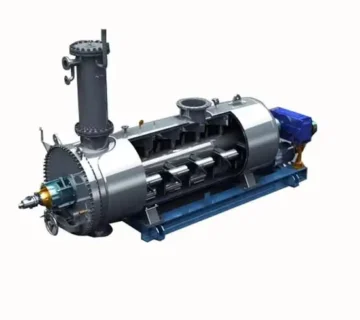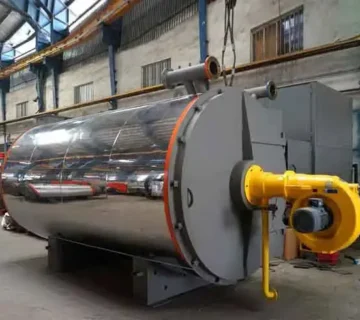Rendering cookers are essential in the slaughterhouse industry for efficiently processing animal by-products. These systems help in recycling waste materials into usable by-products like protein meals and fats, significantly reducing environmental impact. This guide aims to provide insights into selecting the right slaughterhouse waste rendering cooker, covering its types, features, benefits, and factors affecting the decision-making process.
For detailed pricing and specifications, contact the sales department of Niroo Bokhar Araz.
Definition and Basics
A slaughterhouse waste rendering cooker is a specialized industrial device designed to thermally process animal by-products. These cookers use steam pressure and high temperatures to break down materials, sterilize waste, and extract valuable by-products like fat and protein powder. This process not only reduces waste volume but also minimizes odor and contamination, contributing to better waste management and environmental sustainability.
Types of Rendering Cookers
Rendering cookers vary based on design, capacity, and level of automation. The main types include:
- Horizontal Rendering Cookers:
- Suitable for small to medium-scale operations.
- Compact and easy to install.
- Typically equipped with manual controls.
- Vertical Rendering Cookers:
- Designed for larger slaughterhouses.
- Offers high capacity and efficient heat distribution.
- Often includes automated pressure control systems.
- Automated Rendering Cookers:
- Equipped with advanced digital control systems.
- Ideal for large-scale industrial applications.
- Optimized for energy efficiency and precise processing.

Key Factors Affecting the Choice of a Rendering Cooker
- Capacity Requirements:
- Assess daily waste volume to determine the appropriate size and capacity.
- Material and Build Quality:
- Cookers made from heat-resistant stainless steel offer durability and low maintenance costs.
- Pressure and Temperature Ratings:
- Opt for models that meet your required steam pressure and temperature levels.
- Automation Level:
- Automated systems are more efficient but come with higher upfront costs.
- Compliance with Standards:
- Ensure the cooker adheres to CE, DIN, and other relevant certifications for safety and performance.
- Environmental Considerations:
- Look for models designed to reduce energy consumption and emissions.
Benefits of Using Rendering Cookers
Advantages:
- Environmental Impact: Converts waste into reusable by-products, reducing landfill needs.
- Cost Efficiency: Lowers waste disposal costs and generates revenue from by-products.
- Hygiene and Safety: Eliminates harmful pathogens, ensuring compliance with health regulations.
Disadvantages:
- High Initial Cost: Advanced systems require significant investment.
- Maintenance Needs: Regular cleaning and servicing are essential for optimal performance.
Tips for Purchasing a Rendering Cooker
- Evaluate Your Operational Needs: Choose a cooker that aligns with the scale of your operations.
- Check for After-Sales Support: Ensure the manufacturer provides warranty and maintenance services.
- Focus on Energy Efficiency: Look for features that reduce operational costs and environmental impact.
- Verify Certifications: Select cookers compliant with national and international standards.
- Consult with Experts: Seek advice from industry professionals or the manufacturer’s team.

Frequently Asked Questions (FAQ)
- What are the primary uses of rendering cookers?
Rendering cookers process slaughterhouse waste into protein meals and fats for use in various industries. - What capacities are available in rendering cookers?
Capacities range from small units for local operations to large-scale systems for industrial facilities. - Are Niroo Bokhar Araz’s rendering cookers certified?
Yes, all products comply with CE, DIN, and Iranian national standards. - How does a rendering cooker benefit the environment?
It reduces waste volume, minimizes odor, and recycles valuable materials. - What type of material is best for rendering cookers?
Stainless steel is ideal due to its durability, corrosion resistance, and heat tolerance. - How can I determine the correct size of the cooker for my facility?
Evaluate the daily volume of waste processed and consult with a manufacturer for recommendations. - What maintenance does a rendering cooker require?
Regular cleaning, inspection of seals, and checking pressure controls are crucial. - What is the warranty period for Niroo Bokhar Araz products?
Products come with a 10-year warranty and 20 years of after-sales support. - Are automated systems worth the investment?
Yes, automated systems offer higher efficiency and reduced labor costs, making them ideal for large operations. - Where can I get pricing information?
Contact the sales department of Niroo Bokhar Araz for the latest prices and offers.
Conclusion
Choosing the right rendering cooker for your slaughterhouse operations is crucial for maximizing efficiency, reducing costs, and promoting environmental sustainability. Niroo Bokhar Araz provides high-quality, certified rendering cookers tailored to meet diverse industrial needs. For more details and pricing, contact our sales team today.




